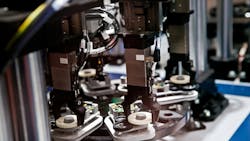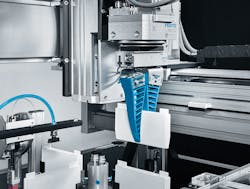Mechatronics is a term originally coined in the 1970s to denote the integration of mechanics and electronics. It has since evolved into a branch of engineering which takes an interdisciplinary approach to integrating mechanical, electrical and electronics as well as telecommunications, computer science and more.
The general industry consensus is that mechatronics is synonymous with automation, robotics and electromechanical solutions. Those working in this field bring together principles of mechanical and electrical systems as well as computing and other technologies to create advanced systems which are smarter and simpler to use.
Although the development of advanced manufacturing systems is often associated with mechatronics, it can also be applied in a range of other applications.
How Does Fluid Power Factor In?
When it comes to mechatronics, fluid power is typically considered a part of mechanical engineering. As hydraulic and pneumatic components remain powerful methods for transmitting energy, they are often used as an actuator within a larger mechatronics system.
Watch our video interview with Craig Hooker, Director of R&D and Mechatronics at Schaeffler in the Americas, to learn more about what constitutes a mechatronics system.
While electric alternatives are used in some applications, there are many which will better benefit from the power density, speed and flexibility offered by fluid power components. Therefore, it is important to understand the requirements of an application as well as the differences between fluid power and other potential power transmission options, such as electromechanical actuators.
A common use case for fluid power components in mechatronic-related applications is robotics. Both hydraulic and pneumatic components can be utilized; hydraulic control offers the high forces and loads required for moving large components in automated systems as an example.
Pneumatics are commonly utilized for the end effectors of robots. This is due to pneumatic components being cost effective and easy to use as well as lightweight and powerful enough for the tasks for which robots are being used.
Beyond gripping, holding or moving objects, pneumatics in robots can also be used for driving, welding or boring tools attached to the end of a robot arm. All of these tasks require fast, reliable and repeatable movements which pneumatics can provide.
READ MORE: Robots and Cobots Present Opportunity for Pneumatics
Electrohydraulic and Electropneumatic Systems
Mechatronics can also come in the form of combining fluid power components with electronic technologies. Electrohydraulic and electropneumatic systems are becoming increasingly more common examples of this through the integration of sensors, software and other components.
Neal Gigliotti, Manager, Applications Engineering, Industrial Hydraulics at Bosch Rexroth said in an interview with Power & Motion that mechatronics have been an integral part of electrohydraulic systems for many years.
“A common example is controlling the position of a hydraulic cylinder,” he said. “A combination of electronic closed loop motion controller, position feedback sensor, and proportional hydraulic control valve with hydraulic drive are used to maintain control of the cylinder position, insuring smooth and accurate motion control.”
Bringing fluid power technologies together with electronics, software and other technologies can provide a range of benefits. It is a trend that will only continue to grow as automation of various types increases as well as electrification and digitization, all of which will require the combining of technologies to ensure performance, productivity and efficiency.
Electromechanical vs. Fluid Power
Electromechanical devices, also often referred to as electric actuators, have become a more common alternative to fluid power due in part to the level of accuracy and force they can provide. These actuators convert rotational force from an electric rotary motor into linear movement using either a belt or a screw.
Compared to hydraulic and pneumatic alternatives, electromechanical actuators offer reduced size, maintenance and energy use which can benefit various applications, particularly factory automation. The use cases for electromechanical devices are growing as technology continues to advance.
Determining which type of device to use – electromechanical or fluid power – for actuation in a mechatronic or other system will depend on the requirements of a given application.
Richard Vaughn, Automation Engineering Manager at Bosch Rexroth, said in a webinar with Power & Motion that it is not necessarily one outweighs the other in many applications but it is important to understand the advantages when choosing between the technologies. He also noted there are times where they could even be used in parallel.
A key benefit offered by electromechanical devices is their lower energy consumption. The energy provided by the devices servo drive can be stored and reused in many cases which can help reduce energy consumption and provide higher mechanical efficiency. The lack of oil or air leaks with these devices is beneficial as well from a maintenance and sustainability standpoint.
Being a servo-driven technology, electromechanical devices offer quieter operation. Vaughn also noted precise following of complex motion profiles are possible with electromechanical components, enabling implementation of much more complex applications than what is possible with pneumatic or hydraulic solutions. This enables quick changes to be made as necessary.
When looking at the advantages offered by fluid power components, higher forces and power density are the key advantage, particularly with hydraulics. These components tend to have longer life spans and are better suited to handle shock loads and vibrations, making them beneficial for applications in harsh environments.
Vaughn said when looking at initial material costs, electromechanical solutions will typically be higher. But if the advantages outweigh those initial costs to achieve lower operating expenses in the long term, then it may be worthwhile to choose the electromechanical option.
Although fluid power alternatives exist, there will always be a place for hydraulic and pneumatic solutions. Understanding application requirements and end use customer needs will remain an important factor for determining when and how to apply fluid power solutions, whether they be in a mechatronic or other type of system.
This article is part of Power & Motion's Fundamentals of Fluid Power: Mechatronics ebook; download the full guide to learn about the latest technologies and design methods for developing modern pneumatic systems.
About the Author
Sara Jensen
Executive Editor, Power & Motion
Sara Jensen is executive editor of Power & Motion, directing expanded coverage into the modern fluid power space, as well as mechatronic and smart technologies. She has over 15 years of publishing experience. Prior to Power & Motion she spent 11 years with a trade publication for engineers of heavy-duty equipment, the last 3 of which were as the editor and brand lead. Over the course of her time in the B2B industry, Sara has gained an extensive knowledge of various heavy-duty equipment industries — including construction, agriculture, mining and on-road trucks —along with the systems and market trends which impact them such as fluid power and electronic motion control technologies.
You can follow Sara and Power & Motion via the following social media handles:
X (formerly Twitter): @TechnlgyEditor and @PowerMotionTech
LinkedIn: @SaraJensen and @Power&Motion
Facebook: @PowerMotionTech

Leaders relevant to this article:



